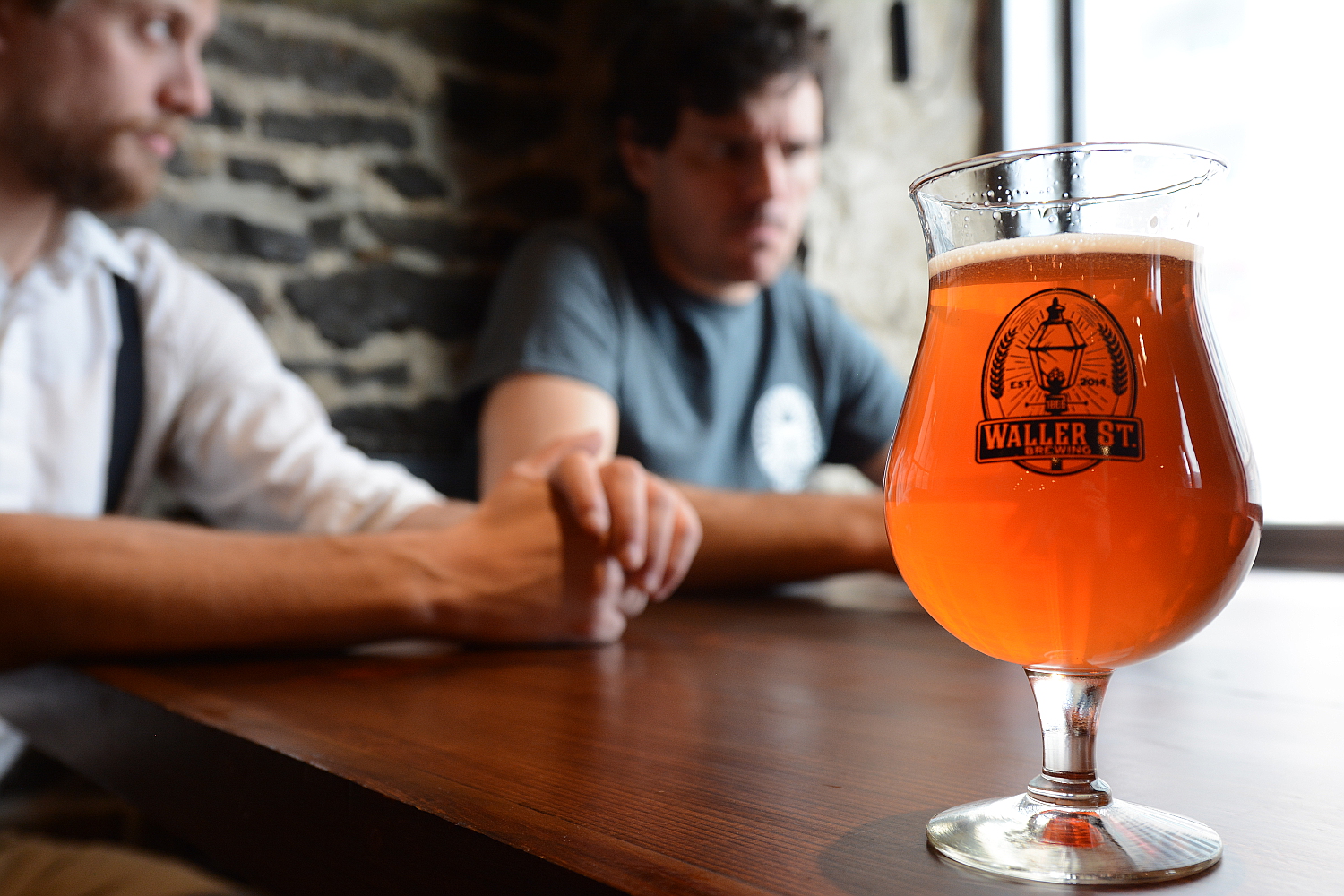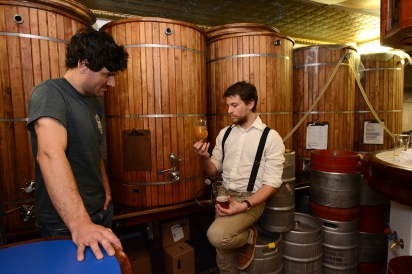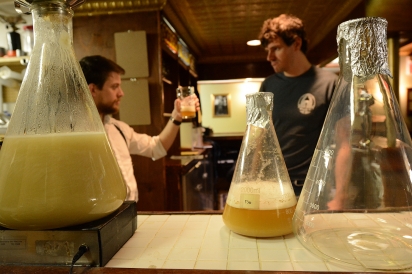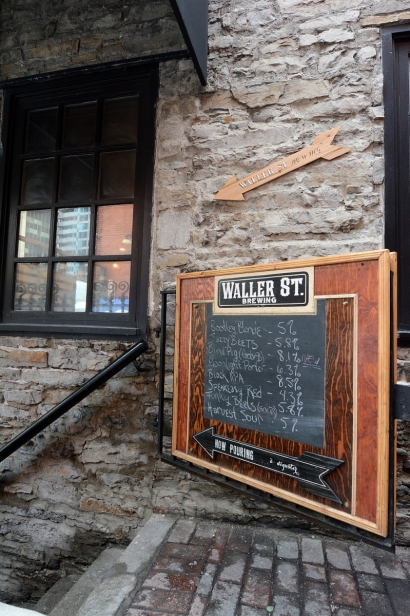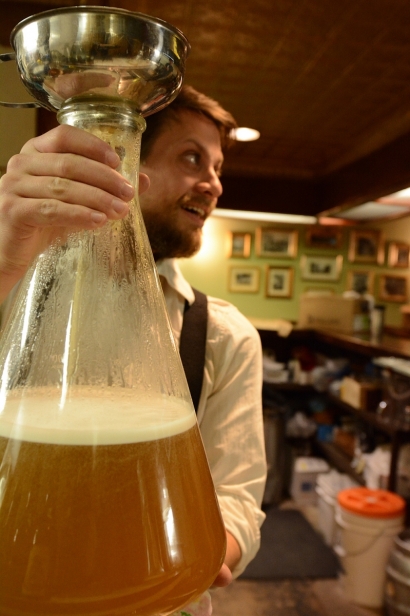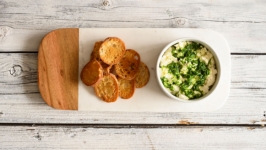Touched by Ingenuity
Waller St. Brewing might be Ottawa’s most inventive brewery. And that’s high praise, since brewers are, by and large, creative and innovative creatures. Head brewer Marc-André Chainey, along with co-owners George Bush (not that one) and Eli Dagher are the team behind the prohibition-style brewery located in the heart of downtown Ottawa.
Though it’s a handsome location now, it didn’t have the aesthetic appeal when the Waller St. folks took over the space, formerly Minglewoods Tap & Grill. Much of the old establishment was reclaimed, including the bar, which was thoroughly cleaned. Today, stained glass windows, repurposed from homes in the neighbourhood, catch the soft lighting around the bar. The tanks are clad in handsome wooden jackets that match the aesthetic of the rest of the bar.
“When we started, the place was quite literally a giant mess,” says Chainey. “Once we started removing all of the clutter and restoring the original wood detailing and stained glass, the original charm of the old English-style pub came back to life. The craftsmanship of the original construction and of the wood cladding made it obvious to me that we needed to show the same level of respect and dedication to the rest of the construction and restoration.”
Located in the basement of a stone heritage building, which was built as a livery stable in 1866, the brewery is defined by its location. Each piece of equipment, including the large fermenting tanks, needed to be carried down the narrow, exterior stairwell and through the small stone entrance. To overcome this obstacle, the brew house was moved inside piece-by-piece and assembled within the building. “The whole brewery was designed from the bottom up to make it work. There is basically not a single piece of equipment that is standard,” says Chainey.
Because of its size, the brewery will never run a canning line or expand its number of tanks. As Waller St. is focused on quality over volume, this is just part of its identity. Without the room to install a brite tank, the beer is carbonated in kegs, using a priming sugar that the remaining yeast will consume, producing carbon dioxide in exchange, without impacting the strength of the alcohol. To activate this yeast, the beer needs to be in motion. The kegs sit on a shaker, a large custom-engineered moving shelf that operates on a timer to rock the kegs. A purpose-built bottle washer is another interesting invention you’ll find in the brewery. Visitors may also note the many shelves built into the walls that are the appropriate size to hold malt bags. The tanks sit on legs that raise the bottom perfectly to accommodate the storage of empty kegs underneath. All of this is reflective of Chainey’s dayjob as an engineer.
But this creative and scientific approach doesn’t end at the engineering of the brewery. Waller St. also boasts an assistant brewer, who is also a microbiologist. Dimitri Carrabin’s primary responsibility at the brewery is to keep the yeast, one of beer’s key ingredients and a living organism, happy and healthy.
This appreciation for yeasts and bacteria is obvious in many of the styles the brewery produces — perhaps most notably in its sours program. The Waller St. team made the decision to always have a sour beer available and has created four sour beers to date: Funky Beets (Cranberry-Beet sour ale), Blind Barron (sour India Pale Ale), Scotch River Sour (a sour farmhouse ale made with local birch tree sap, spruce tips and a unique bacterial strain of Lactobacillus) and Harvest Sour (brewed with local wild hops and unique strains of Brettanomyces yeast and Lactobacillus).
While a sour beer doesn’t have the most appealing name, it is gaining popularity locally. This ancient Belgian-style beer uses various yeast strains and bacterial cultures during the fermentation process to alter the flavour of the brew — giving it a sour, puckerable quality. Like avant-garde music or funky blue cheeses, sours are not particularly mainstream, but their fans are devoted.
As the craft beer industry grows, the range of styles of beer offered also expands. And so, other local breweries are beginning to work with sour beers: the brand-new Small Pony Barrel Works brewery plans on exclusively working with sour beers; Beyond the Pale typically releases a sour at least once a year; and Dominion City Brewing Co., as part of their new expansion, will have a dedicated funk lab to brew beer using wild strains of yeast.
Often overshadowed by hops and malt, yeast is really the magic maker of the team. Without these unicellular organisms or fungi, there is no alcohol. Yeast forms naturally and consumes carbohydrates while producing carbon dioxide and alcohols. But yeast does even more than create alcohol and carbonation; it releases different esters that can create flavours like banana, citrus or even barnyard funk. For instance, the distinct banana-flavour in a hefeweizen is produced by esters created during fermentation. Working with these esters can produce wonderfully complex flavour profiles, but it requires meticulous science, especially when producing beer in large quantities.
“Yeast requires more precision and therefore more sophisticated appliances than what you would find at the home brewing scale,“ Carrabin says.
Yeast's importance in the creation of beer has been neglected for centuries. The 1516 Bavarian law of purity dictated that the only ingredients allowed in beer were water, barley and hops. Yeast was left off the list. To be fair to those medieval lawmakers, the biological contribution of yeast wasn’t yet understood and the seemingly random transformation into beer was normally attributed to divine intervention. When Louis Pasteur, the 19th-century French chemist and microbiologist, invented the microscope, it finally allowed scientists to give yeast the respect it deserved.
“From a biological point of view, fermentation is a way for the micro-organism to survive in an environment where competition for nutrients exists between bacteria and yeasts. Yeast uses a fermentative metabolism that multiplies very slowly and produces alcohol. This alcohol will prevent the growth of any competition and leave room for yeast to quietly monopolize all the nutrients.”
The Waller St. brewers insist that each beer is created with a new yeast culture. Re-pitching or reusing yeast from a previous brewing process is a common practice, but not one to which Waller St. prescribes. “After its service, the yeast is graciously thanked and placed in the compost,” Carrabin says. The yeast faces various stressors with each brewing process and Carrabin prefers his yeast to be as fresh and stress-free as possible.
The care and precision taken at Waller St. Brewing means you can rest easy, too — over a pint of the good stuff.
Waller St. Brewing
14 Waller St., Ottawa, Ont.
wallerst.ca, 613.860.1515


